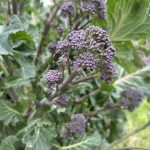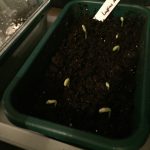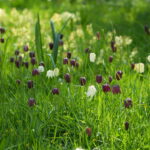Around the world the vast majority of plants on earth grow in a mix of mineral soil and composted organic matter – only those in peatland grow in peat. Over the last ten years I have grown almost every plant and crop available to home gardeners more than successfully in peat free compost using a little organic seaweed or homemade liquid fertiliser and I have always found peat free compost to be excellent.
I love peat free compost’s open and free draining structure giving me unparalleled control of the vital technique of watering. All good compost however must be water retentive and this is a challenge in all composts, particularly in the early spring months when cold wet compost can cause issues with seedlings.
Unfortunately, the transition from peat based composts to peat free compost has put all of the focus on the compost. Peat free compost has become the scapegoat for all gardening challenges – of which there are many when growing plants.
I’m reluctant to recommend brands of compost these days partly because I’ve recommended loads for the last ten years to people thousands of times and I’m exhausted by it (it’s like living in Groundhog Day). But also because I think it’s the wrong question, the main question I think people should ask is how do I identify the real problem with my plants?
For the record though I’ve used Sylvagrow, Dalefoot, New Horizon, Fertile Fibre, B&Q Own Brand, homemade and local community composted waste (which is more a soil improver so for seedlings I add a bit of molehill soil). There are probably others. I love the texture of Sylvagrow Organic peat free but that’s really hard to get hold of. But to be honest, I don’t really care which brand I use because it doesn’t matter at all – I can grow plants in anything. You can too!
Steps to work out if a compost is better or worse than others
This is for potting compost, soil improver is more coarse and as long as it’s slightly composted plant material, I don’t care what that is like.
- Is it in date? Look to see if the bag is from this year or the previous year. Nutrients can change over time, so it’s best to buy only bags from this year. Or if you have old bags, use these on soil as a soil improver.
- Have others recommended it? If people like me and other professional gardeners are using it, it’s probably pretty good! Too often people complain to me that brand X and Y that I’ve never heard of are rubbish. Give them a go, but if they’re not great, try something that experts actually recommend.
- Does it feel right? I’m not bothered about super fine seedling compost, I prefer mixed grade for good drainage but it does need some small bits. Compost should feel half light and a little damp, open and with a good amount of fine textured content. I don’t care if it has little bits of twig in, in fact I prefer that to help keep it open and free draining, but if it’s all wood and twigs, stuff will probably struggle in it.
- Use more than one brand alongside one another. If you grow the same plants in different composts but in the same conditions, are they any different? Compare brands yourself in this way until you find the one you are most happy with. See what I did in my peat vs peat free trial a few years ago.
If not the compost, what should I focus on?
You’re probably thinking, if I’m saying the peat free compost isn’t usually the problem, what is? It’s a good question and the answer is as old as gardening itself. Rather than worrying about the compost I would suggest everyone focus on:
Watering
Watering is the number one cause of problems for all gardeners, experienced or amateur alike. There is no exact answer, good watering comes with experience. But I know that whenever a gardener has told me their peat free compost isn’t working and I’ve either seen the plants in photos or in person it is 9 times out of 10 that something has gone wrong with the watering. It is difficult to get watering right, I struggle even now and I expect I always will from time-to-time.
It is especially challenging with seedlings in small pots in spring. The best way I can explain it is that a pot of compost is like a sponge, drench it and it can become too wet. On cold spring days and nights, this can cause poor growth, weakened plants, root rot, damping off, poor germination, algae on surfaces etc. Same with plants growing in pots for long periods, such as many years, their roots can be affected in winter if too wet.
To make the situation right, you need something to dry the sponge out. This is usually the sun and warmth, plus a living plant drawing the water up and transpiring. If a seedling is small it will not transpire enough to dry the compost out, especially on cold days. Drainage is also a factor but of course seedlings are often put in trays to help keep the water in exacerbating the problem.
As gardeners we have to make a judgement to get the amount of water right. This means knowing how not to overwater while still giving the plants enough. And also to recognise when we’ve overwatered and how to rectify that. For instance, by moving the plant undercover out of rain, such as into a polytunnel until it dries out a bit. If really saturated, it can be better to plant into another pot.
Personally I have always found peat free compost to be the perfect balance of free draining and water retentive, however some have a tendency to dry out on the surface leading people to over water. Meaning it’s best to scrape around with a finger or use weight as a better assessment of whether they need watering. I also look underneath at the holes to see if the compost is damp there, if it is I won’t water.
The other thing people struggle with is the distinction between damp and wet. Wet is too much water for most plants, damp like a wrung out sponge with air in the gaps is better. I notice everyone near us in Yorkshire tells me the soil is dry in summer despite the plants all around us being lush and green – it’s not dry, it’s not wet, but it is damp and that’s clearly just right for plants.
Fertiliser
Plants in pots need fertiliser, including seedlings once they get their first few true sets of leaves. I liquid fertilise seedlings every two weeks or so in spring, but erring on the side of less while they’re young.
The challenge of course is watering again. If the compost is soggy and the plant is unhappy, how do you fertilise without making the water situation worse? Well, the answer is that you can’t, and that’s led to people again thinking it’s the compost.
The one thing I do to allow me to fertilise soggy compost plants is first manage the water. If the plant is too wet I won’t fertilise until I’ve dried the compost out more.
Cultivars and seed viability
The number one time I know peat free compost isn’t the problem is when people say “my seeds didn’t germinate” because I can literally get seeds to germinate in sand or even only on a plate of water – we’ve all grown cress on kitchen paper as kids. Yes chemical composition of compost can affect germination but this is such a minute fraction of an issue that it really only matters for industrial growers, home gardeners won’t even notice. It is highly unlikely seeds won’t germinate at home because of the composition of the compost.
If no seeds are germinating something is going wrong elsewhere. The seeds might not be viable (dead or unable to germinate), the compost might be too wet or the situation too cold or not light enough. Some seeds need stratification (a period of winter cold) or scarification (cutting the seed coat).
As an example, I have never had anything but near 100% germination of tomatoes in any compost – I’ve grown hundreds of the things down south and up north. The only time one cultivar didn’t germinate, none in that batch did. The seeds were not viable (dead), it had nothing to do with the compost because all of the others grew.
I noticed one trial of tomatoes in peat free compost said different brands of compost led to different germination. This doesn’t make sense to me because tomatoes germinate without compost. Something else went wrong. Perhaps bad seed viability or incorrect temperature. Though I suspect what actually happened again is a problem with watering. That trial mentioned they watered seed trays from beneath. I suspect the tomato seeds didn’t receive enough water to germinate. Had they watered from above with a fine rose watering can, perhaps they would have had more success.
I hope that helps a bit – focus on watering and other cultivation, use compost brands other people like using and keep your fingers crossed for a warm, sunny spring! Now, let’s hope the Government gets that promised peat free compost ban done. We need to stop digging up natural peatland habitat just so we can grow some plants at home. Peat stores huge amounts of carbon in the ground and is a precious habitat for all manner of wildlife that can only live there.



